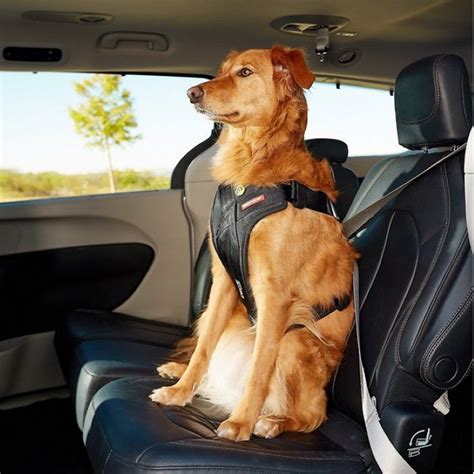Introduction
As responsible pet owners, ensuring the safety of our furry companions during car rides is paramount. With the alarming statistics indicating that thousands of dogs die in car accidents annually, it’s crucial to equip our vehicles with vital safety accessories to protect our beloved pets. This comprehensive guide will illuminate the essential dog car safety accessories, empowering you to make informed decisions and safeguard your furry friends during journeys.

Primary Safety Measures
1. Harnesses and Seat Belts
Harnesses, when properly fitted, provide the most secure restraint for dogs in vehicles. They distribute force evenly across the dog’s chest, preventing injuries in the event of a collision. Look for harnesses that are crash-tested and certified by organizations such as the Center for Pet Safety (CPS). Seat belts specifically designed for dogs are also available, offering a secure attachment to the vehicle’s seat.
2. Crates and Carriers
Crates or carriers provide a safe and enclosed space for dogs within the vehicle. They prevent them from wandering around the car and getting into dangerous situations. Choose a crate or carrier that is the appropriate size for your dog, allowing them to stand up, turn around, and lie down comfortably.
Additional Safety Considerations
3. Dog Seat Covers
Seat covers protect your vehicle’s upholstery from pet hair, dirt, and scratches. They also provide a comfortable and secure surface for your dog to sit or lie on, reducing the risk of them sliding around during sudden stops or turns.
4. Window Guards and Barriers
Window guards prevent dogs from sticking their heads out of open windows, which can lead to injuries from debris or objects. Barriers, such as cargo nets or pet gates, create a physical division between the driver and the dog, preventing distractions and potential accidents.
5. Reflective Gear and Leashes
If you need to exit the vehicle with your dog during an emergency or roadside stop, reflective gear and leashes ensure that they remain visible to other drivers. Consider using high-visibility vests, collars, or leashes to enhance their safety.
Considerations for Different Dog Sizes and Breeds
Small Dogs: Small dogs, such as Chihuahuas and Yorkies, may require specialized safety accessories. Harnesses designed specifically for small breeds provide a secure and comfortable fit. Consider carriers that are the appropriate size to accommodate their small stature.
Large Dogs: Large dogs, such as German Shepherds and Golden Retrievers, require more robust safety accessories. Harnesses with larger chest straps and sturdy buckles are essential to ensure proper restraint. Crates or carriers designed for large breeds provide ample space for their size and comfort.
Brachycephalic Dogs: Brachycephalic breeds, such as Pugs and Bulldogs, have short snouts and flat faces, making them more susceptible to breathing difficulties. Consider harnesses that do not put pressure on their neck and airways. Additionally, provide plenty of ventilation within the vehicle to ensure their comfort and safety.
Current Status and Future Trends
The demand for dog car safety accessories has been steadily increasing, driven by growing awareness of pet safety and advancements in technology. According to the American Pet Products Association (APPA), the pet industry is projected to reach $109.6 billion by 2025. Within this industry, the market for pet safety products is expected to experience significant growth.
Emerging technologies, such as GPS tracking devices and smart crates, are revolutionizing the way we monitor and protect our pets during travel. These innovative products offer peace of mind and enhanced safety features, ensuring that dogs are secure and accounted for throughout their journeys.
Tips and Tricks for Safe Car Rides
- Accustom your dog to car travel: Gradually introduce your dog to short car rides, rewarding them with treats or praise for calm behavior.
- Avoid feeding your dog before traveling: To prevent car sickness, refrain from feeding your dog within 2-3 hours before a car ride.
- Create a comfortable environment: Provide a cozy blanket or bed within the crate or carrier to make the ride more enjoyable for your dog.
- Take frequent breaks: Stop every 2-3 hours for your dog to stretch, relieve themselves, and hydrate.
- Never leave your dog unattended in the car: Even on mild days, temperatures can rise rapidly inside a vehicle, posing a serious risk to your dog’s health.
Comparative Analysis of Dog Car Safety Accessories
| Type of Accessory | Pros | Cons |
|---|---|---|
| Harnesses | – Provides secure restraint | – Can be uncomfortable for some dogs |
| Seat Belts | – Convenient and easy to use | – May not be as secure as harnesses |
| Crates and Carriers | – Enclosed and secure space | – Can be bulky and difficult to transport |
| Seat Covers | – Protects vehicle upholstery | – May not provide sufficient restraint for dogs |
| Window Guards | – Prevents dogs from sticking heads out of windows | – Can restrict airflow and visibility |
| Barriers | – Creates a physical division between driver and dog | – May not be suitable for all vehicles |
Conclusion
Equipping our vehicles with essential dog car safety accessories is a non-negotiable step in ensuring the well-being of our furry companions during car rides. By choosing appropriate accessories based on your dog’s size, breed, and individual needs, we can create a safe and comfortable traveling environment for them. As technology continues to advance, we can expect even more innovative and effective safety products to emerge, further enhancing the protection of our beloved pets on the road. By investing in these accessories and following safe driving practices, we can give our dogs the peace of mind and security they deserve, enabling them to enjoy the adventure of car travel alongside their human companions.





















